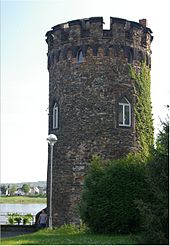Engers Castle
The Engers Castle is located directly on the Rhine in Neuwied district Engers in Rhineland-Palatinate . The Archbishop of Trier and Elector Johann Philipp von Walderdorff had it built between 1759 and 1764 as a hunting , pleasure and summer palace according to plans by Johannes Seiz .
The late baroque palace building is now home to the office of the Landesmusik-Stiftung Villa Musica , a museum area with old musical instruments and paintings of electoral princes and a restaurant in the palace cellar.
history
Kunostein Castle
The Archbishop of Trier Kuno von Falkenstein acquired the town of Engers in 1371 and built Kunostein Castle on the banks of the Rhine . His brother and successor Werner von Falkenstein moved the customs station from Stolzenfels Castle near Koblenz to Engers. Kunostein Castle thus became a customs castle . It survived the Middle Ages without major damage.
In 1757, the then Archbishop and Elector Johann Philipp von Walderdorff decided to modernize the castle. This project is interpreted as a reaction to the founding of the city of Neuwied . He changed his plan and had the castle demolished in 1758. Today the gray tower of the old customs station is still preserved.
Engers Castle
The architect Johannes Seiz , a student of Balthasar Neumann , was commissioned to plan the work for a new castle. With the participation of the court plasterer Michael Eytel , the Koblenz painter Januarius Zick and the sculptor Ferdinand Dietz , the late Baroque, still well-preserved Engers Castle was built from 1759 to 1762 on the site of the former Kunostein Castle.
The elector only stayed at Engers Castle during the hunting season in September. The rest of the time, the castle stood empty and was opened to visitors who were passing through. The elector had other pleasure palaces built in Wittlich and Molsberg . Johann Philipp von Walderdorff died in 1768. After the end of the electorate, the palace was assigned to the Prince of Nassau-Weilburg as a summer residence in 1803 . After the Congress of Vienna , Engers became Prussian and the area was used as a war school between 1862 and 1914 . In the war times of 1870/71 and between 1914 and 1917 it served as a reserve hospital.
In 1928 the area was sold to the Josefs-Gesellschaft and a home, healing and teaching institution for people with disabilities was established. From the hospital, the school developed the Heinrich-Haus belonging Christiane-Herzog-school with a program focusing on motor development.
In 1990 the castle building was taken over by the state of Rhineland-Palatinate and has been home to the state foundation Villa Musica since 1995 .
Immediately adjacent to the castle upstream is the neo-baroque house of the masters (the so-called master’s house), built around 1900, who were trained in the Heinrich House . The Rhineland-Palatinate State Music Academy is located in the building, which was renovated in 2003 .
Usage and events
The Landesstiftung Villa Musica uses the building to train young musicians in chamber music.
In the Mirror Hall (Hall of Diana), 1st floor, the wall paintings and ceiling frescoes by Januarius Zick contributes regularly for performances of chamber music instead. In the adjacent rose room there are extraordinary stucco work by Michael Eytel .
In the museum of the castle you can see paintings of electorate princes, baroque furniture and old musical instruments.
On May 19 and 21, 2005 special events were held to commemorate the move of Villa Musica into Engers Castle ten years earlier.
various
After 324 km, the Thuringia-Rhine hiking trail , which has existed since 1936 and was reopened in 1993, ends at Engers Castle , the one from Rennsteig on the Großer Inselsberg via Oberellen , Bad Hersfeld , Alsfeld , Homberg (Ohm) , Staufenberg , Herborn , Westerburg , Höhr-Grenzhausen and Engers leads. Traditionally, hikers throw stones from the Thuringian Forest in Engers into the Rhine.
As an extraordinary place, Engers Castle is one of the masterpieces between the Rhine and Moselle .
literature
- Alexander Thon, Stefan Ulrich: "... like a monarch enthroned in the middle of his court". Castles on the Lower Middle Rhine . Schnell & Steiner, Regensburg 2010, ISBN 978-3-7954-2210-3 , pp. 64–67 (especially on the predecessor castle Kunostein).
See also
Web links
- Official website of Schloss Engers
- Engers Castle at VillaMusica.de
- Website of the Landesmusikakademie Rheinland-Pfalz
Coordinates: 50 ° 25 ′ 21 ″ N , 7 ° 32 ′ 37 ″ E







